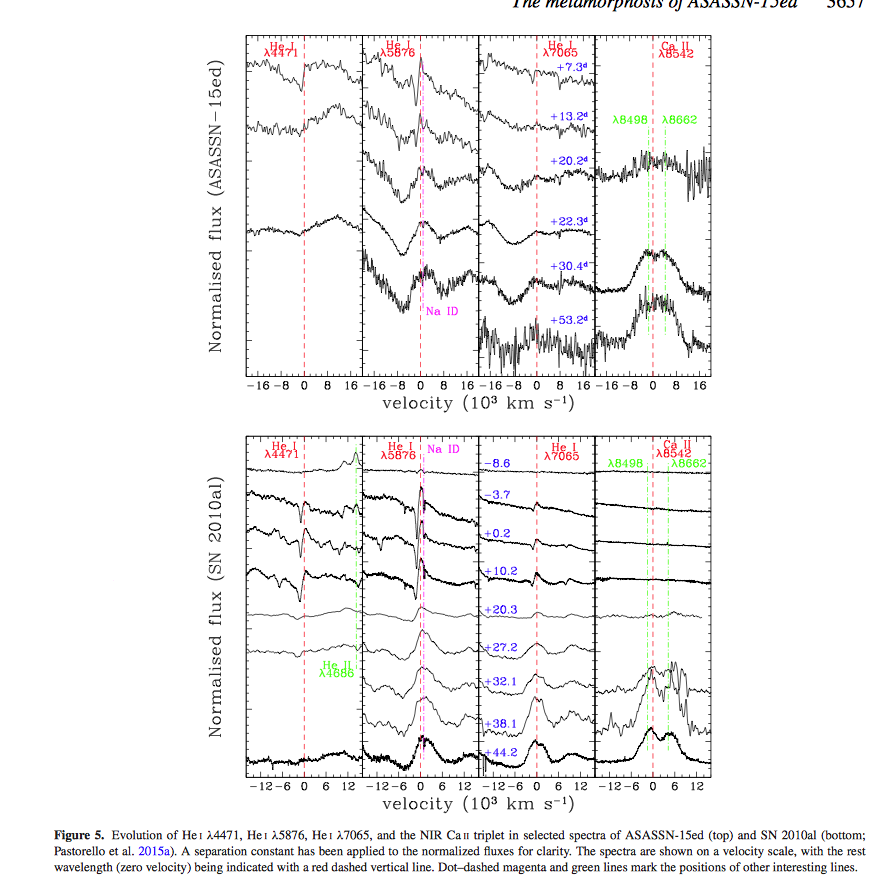Padova-Asiago Supernova Group
Highlights
Massive stars exploding in a He-rich circumstellar medium - VII. The metamorphosis of ASASSN-15ed from a narrow line Type Ibn to a normal Type Ib SN
Pastorello, A. et al. 2015 MNRAS 453, 3650 (link to pdf)
We present the results of the spectroscopic and photometric monitoring campaign of ASASSN-15ed. The transient was discovered quite young by the All Sky Automated Survey for SuperNovae (ASAS-SN) survey. Amateur astronomers allowed us to sample the photometric SN evolution around maximum light, which we estimate to have occurred on JD = 2457087.4 +/- 0.6 in the r band. Its apparent r-band magnitude at maximum was r = 16.91 +/- 0.10, providing an absolute magnitude Mr ~ -20.04 +/- 0.20, which is slightly more luminous than the typical magnitudes estimated for Type Ibn SNe. The post-peak evolution was well monitored, and the decline rate (being in most bands around 0.1 mag d-1 during the first 25 d after maximum) is marginally slower than the average decline rates of SNe Ibn during the same time interval. The object was initially classified as a Type Ibn SN because early-time spectra were characterized by a blue continuum with superimposed narrow P-Cygni lines of He I, suggesting the presence of a slowly moving (1200-1500 km s-1), He-rich circumstellar medium. Later on, broad P-Cygni He I lines became prominent. The inferred velocities, as measured from the minimum of the broad absorption components, were between 6000 and 7000 km s-1. As we attribute these broad features to the SN ejecta, this is the first time we have observed the transition of a Type Ibn SN to a Type Ib SN. 69
Pastorello, A. et al. 2015 MNRAS 453, 3650 (link to pdf)
We present the results of the spectroscopic and photometric monitoring campaign of ASASSN-15ed. The transient was discovered quite young by the All Sky Automated Survey for SuperNovae (ASAS-SN) survey. Amateur astronomers allowed us to sample the photometric SN evolution around maximum light, which we estimate to have occurred on JD = 2457087.4 +/- 0.6 in the r band. Its apparent r-band magnitude at maximum was r = 16.91 +/- 0.10, providing an absolute magnitude Mr ~ -20.04 +/- 0.20, which is slightly more luminous than the typical magnitudes estimated for Type Ibn SNe. The post-peak evolution was well monitored, and the decline rate (being in most bands around 0.1 mag d-1 during the first 25 d after maximum) is marginally slower than the average decline rates of SNe Ibn during the same time interval. The object was initially classified as a Type Ibn SN because early-time spectra were characterized by a blue continuum with superimposed narrow P-Cygni lines of He I, suggesting the presence of a slowly moving (1200-1500 km s-1), He-rich circumstellar medium. Later on, broad P-Cygni He I lines became prominent. The inferred velocities, as measured from the minimum of the broad absorption components, were between 6000 and 7000 km s-1. As we attribute these broad features to the SN ejecta, this is the first time we have observed the transition of a Type Ibn SN to a Type Ib SN. 69
